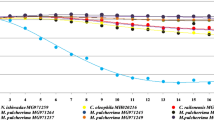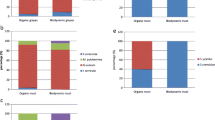Abstract
This work describes the influence of yeast population on the chemical characteristics of wine obtained by spontaneous and inoculated fermentation of must from Vitis vinifera Lado, a minor white grapevine autochthonous to Galicia (NW Spain). The study was carried out for two consecutive years. The results showed that musts derived from Lado presented a high acidity though the potential alcohol level was acceptable. The genetic diversity of S. cerevisiae strains isolated from spontaneous fermentations was low, probably due to must characteristics, although these did not interfere with the implantation of the commercial strains used. Analyses showed that the wines subsequently produced had high alcoholic levels and very high acidities (pH 3.0) as was expected from must composition. Wines obtained from spontaneous fermentations had a lower alcohol content but higher total acidity than those from inoculated fermentations. Monovarietal wines produced from Lado were poorly evaluated in sensorial tests because of their unbalanced structure and sourness; however, when they were mixed with other autochthonous white varieties with less acidity, the resulting wines were well accepted.



Similar content being viewed by others
References
Anonymous (1993) Métodos oficiales de análisis, Tomo II. Ministerio de Agricultura, Pesca y Alimentación, Madrid, Spain
Beltran G, Torija MJ, Novo M, Ferrer N, Poblet M, Guillamón JM, Rozes N, Mas A (2002) Analysis of yeast populations during alcoholic fermentation: a six year follow-up study. Syst Appl Microbiol 25:287–293
Bisson LF (1999) Stuck and sluggish fermentations. Am J Enol Vitic 50:107–119
Blanco P, Orriols I, Losada A, Cortés S (2006) Estudio de la capacidad fermentativa de distintas levaduras autóctonas (S. cerevisiae) con mosto Albariño y su influencia en la composición del vino. Tecnol Vino 33:37–43
Blanco P, Ramilo A, Cerdeira M, Orriols I (2006) Genetic diversity of wine Saccharomyces cerevisiae strain in an experimental winery from Galicia (NW Spain). Antonie Leeuwenhoek 89:351–357
Carballeira Lois L, Cortés Diéguez S, Gil de la Peña ML, Fernández Gómez E (2001) SPE-GC determination of aromatic compounds in two varieties of white grape during ripening. Chromatographia 53:350–355
Casey GP, Ingledew WM (1986) Ethanol tolerance in yeasts. CRC Crit Rev Microbiol 13:219–280
Charoenchai C, Fleet GH, Henschke PA (1998) Effects of temperature, pH, and sugar concentration on the growth rates and cell biomass of wine yeasts. Am J Enol Vitic 49:283–288
Constantí M, Poblet M, Arola L, Mas A, Guillamón JM (1997) Analysis of yeast populations during alcoholic fermentation in a newly established winery. Am J Enol Vitic 48:339–344
Egli CM, Edinger WD, Mitrakul CM, Henick-Kling T (1998) Dynamics of indigenous and inoculated yeast populations and their effects on the sensory character of Riesling and Chardonnay wines. J Appl Microbiol 85:779–789
Esteve-Zarzoso B, Manzanares P, Ramón D, Querol A (1998) The role of non-Saccharomyces yeasts in industrial winemaking. Int Microbiol 1:143–148
Falqué E, Fernández E, Dubourdieu D (2001) Differentiation of white wines by their aromatic index. Talanta 54:271–281
Falqué E, Fernández E, Dubourdieu D (2002) Volatile components of Loureira, Dona Branca and Treixadura wines. J Agric Food Chem 50:538–543
Fernández B, Iglesias I, Rego F, Cid N (2005) Caracterización ampelográfica de diferentes variedades de vid cultivadas en Galicia. Tecnol Vino 27:39–47
Fleet GH (2003) Yeast interactions and wine flavour. Int J Food Microbiol 86:169–180
Fleet GH, Heard GM (1993) Yeasts-growth during fermentation. In: Fleet GM (ed) Wine microbiology and biotechnology. Harwood Academic Publishers, Chur, pp 27–54
Freijanes J, Alonso MP (1997) Variedade Lado. In: Xunta de Galicia, Videiras galegas (eds) Catálogo de variedades autóctonas. Santiago de Compostela, pp 37–39
Gil JV, Mateo JJ, Jimenez M, Pastor A, Huerta T (1996) Aroma compounds in wine as influenced by apiculate yeasts. J Food Sci 61:1247–1249
Heard GM, Fleet GH (1986) Evaluation of selective media for enumeration of yeasts during wine fermentation. J Appl Bacteriol 60:477–481
Henick-Kling T, Edinger W, Daniel P, Monk P (1998) Selective effects of sulfur dioxide and yeast starter culture addition on indigenous yeast populations and sensory characteristics of wine. J Appl Microbiol 84:865–876
Herraiz T, Reglero G, Herraiz M,Martin-Alvarez P, Cabezudo M (1990) The influence of the yeast and type of culture on the volatile composition of wines fermented without sulfur dioxide. Am J Enol Vitic 41:313–318
Lambrechts MG, Pretorius IS (2000) Yeast and its importance to wine aroma—a review. S Afr J Enol Vitic 21:97–129
Lema C, García-Jares C, Orriols I, Angulo L (1996) Contribution of Saccharomyces and non-Saccharomyces populations to the production of some components of Albariño wine aroma. Am J Enol Vitic 47:206–216
Mateo JJ, Jimenez M, Huerta T, Pastor A (1991) Contribution of different yeasts isolated from musts of Monastrell grapes to the aroma of wine. Int J Food Microbiol 14:153–160
Mora J, Mulet A (1991) Effects of some treatments of grape juice on the population and growth of yeast species during fermentation. Am J Enol Vitic 42:133–136
Pallmann CL, Brown JA, Olineka TL, Cocolin L, Mills DA, Bisson LF (2001) Use of WL medium to profile native flora fermentations. Am J Enol Vitic 52:198–203
Querol A, Barrio E, Ramón D (1992) A comparative study of different methods of yeast strain characterization. Syst Appl Microbiol 15:439–446
Romano P, Fiore C, Paraggio M, Caruso M, Capace A (2003) Function of yeast species and strains in wine flavour. Int J Food Microbiol 86:169–180
Romano P, Suzzi G, Comi G, Zironi R (1992) Higher alcohol and acetic acid production by apiculate wine yeasts. J Appl Bacteriol 73:126–130
Sambrook J, Russell DW (2001) Molecular cloning: a laboratory manual, 3rd edn. Cold Spring Harbour Laboratory Press, New York
Vázquez I, Soto E, Rodríguez JM, Losada A, Orriols I (2006) Aproximación a las características de los vinos de las DO Gallegas. Tecnol Vino 29:46–51
Versini G, Orriols I, Dalla Serra A (1994) Aroma components of Galician Albariño, Loureira and Godello wines. Vitis 33:165–170
Vilanova M, Sieiro C (2006) Contribution by Saccharomyces cerevisiae yeast to fermentative flavour compounds in wines from cv. Albariño. J Ind Microbiol Biotechnol 33:929–933
Acknowledgements
This work was supported by the Spanish Government grant VIN03-029 from Instituto Nacional de Investigación y Tecnología Agraria y Alimentaria (INIA) and by FEDER research funds.
Author information
Authors and Affiliations
Corresponding author
Rights and permissions
About this article
Cite this article
Blanco, P., Vázquez-Alén, M. & Losada, A. Influence of yeast population on characteristics of the wine obtained in spontaneous and inoculated fermentations of must from Vitis vinifera Lado. J Ind Microbiol Biotechnol 35, 183–188 (2008). https://doi.org/10.1007/s10295-007-0282-9
Received:
Accepted:
Published:
Issue Date:
DOI: https://doi.org/10.1007/s10295-007-0282-9




